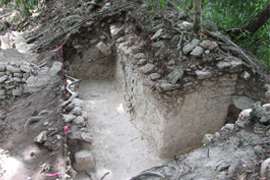
Research in Belize Leads to Revised Timeline of Ancient City’s History
Dating the growth and decline of cities of ancient Maya civilization is complicated, particularly when hieroglyphic texts are either absent or too eroded to decipher. In such cases, researchers must rely on construction histories and ceramics deposits to measure change. The ancient city of La Milpa, Belize, is no exception. In its heyday during the late eighth to early ninth centuries A.D., La Milpa was believed to have been a Maya city with political power and influence. It was also believed that the site was rapidly abandoned in the early ninth century prior to the completion of several construction projects.
New research, however, shows La Milpa may have built up more gradually and declined slower than previously understood, leading researchers, including University of Maine anthropologist Gregory Zaro, to believe this city persisted generations longer than first thought. Zaro and co-author Brett Houk of Texas Tech University, who published their findings in the journal Ancient Mesoamerica, found evidence that La Milpa persisted into the 10th century. Their revised chronology, anchored largely to new radiocarbon dates and the presence of ceramics known to have been produced very late in Classic Maya civilization, has implications for previous models of ancient Maya population growth, decline, and ultimately the collapse of Classic Maya civilization in the eastern Petén region of Guatemala and Belize.
“The investigation of ancient urban landscapes, in the Maya region and elsewhere, generates comparative information for contemporary urban life around the world,” Zaro says. “Such studies provide insight into the growth and evolution of urban life, its resilience to cultural and environmental forces of change, and ultimately collapse. Because archaeology deals with timescales stretching thousands of years into the past, ancient cities provide natural laboratories to unravel past human responses to processes that continue to challenge society today.”
The researchers’ findings are based on excavations and examinations of La Milpa’s built environment. Such construction histories in ancient Maya civilization are useful in determining characteristics like labor appropriation and history. Data from their research in the site’s monumental core show La Milpa has much more pronounced Late Preclassic occupation (an era that lasted from about 400 B.C. to about 250 A.D.) that extended into the southern part of the core. And although its greatest expansion did occur during the late eighth to early ninth centuries, it appears there was a more gradual buildup prior to large-scale Late Classic construction (600 A.D.–800/850 A.D.) than previously understood.
In addition, excavations showed rooms that were left in a clean state, void of any artifacts, indicating an orderly, prolonged departure rather than a steep decline. Zaro and Houk suggest this evidence, combined with the construction time line, indicates a persistence in the presence of elite society into the 10th century, despite the waning of political power.
Zaro’s and Houk’s research also unexpectedly uncovered a Late Preclassic platform in La Milpa’s southern plazas that represents the only one of its kind and era at the site outside the northern plaza. If the construction time line is consistent with other buildings in the southern section of the site, the authors wrote, then La Milpa’s monumental core area would have been larger during the Late Preclassic period.
Contact: Jessica Bloch, (207) 581-3777
